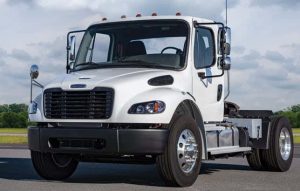Medium Duty Truck Sales Are On The Rise In 2015
Industry reports issued shortly after the first of the year indicated medium duty truck sales rose 10% in January compared to January 2014, although sales were considerably lower than December 2014 levels. A total of 13,316 Class 4-7 trucks were sold in the US in January, whereas the December total was 18,731.
This is not evidence of a decline, say industry experts, because sales of medium duty trucks are always brisk at the end of the year, as buyers take advantage of last-minute tax benefits. In fact, ACT Research Co. representatives said they expected 2015 to be a growth year. They increased their forecast for sales in Classes 5-7 to 220,000 trucks, noting a steady 7-month rise in sales figures. (212,100 were sold in 2014.)
So what’s the outlook now that we’re mid-way through 2015?
ACT Research continues to be bullish on Class 5-7 truck sales, noting that medium duty trucks and also bus orders are boosting sales in that sector. March sales grew 14% compared to March 2014. In contrast, however, Class 8 truck sales are weak. ACT blames that on a 7-month backlog of as-yet-unfulfilled orders placed in 2014. Nonetheless, they predict Class 8 sales will total 300,000 units by the end of this year.
Medium duty truck trends are generating greater interest from prospective buyers.
Aside from pent-up demand, industry watchers say multiple improvements in medium duty trucks are increasing demand. For 2015, key trends continue to be:
- Lighter weight trucks, to improve fuel economy without sacrificing fleet productivity.
- Expanding powertrain options to further improve fuel economy and reduce emissions.
- Including more safety features such as reverse sensing systems and back-up cameras on base-level models rather than offering them only on upgraded models.
- Offering more technology-based options such as emissions systems, electronics, APUs and more complex transmissions.
- Switching to LED lighting, which lasts longer and draws less electricity.
There is also a generalized trend away from manual transmissions and toward automatics and automated-manual hybrid transmissions. Experts say this change is driven by the nationwide driver shortage and concerns that younger drivers are inexperienced with manual transmissions.
Fleet managers are instituting changes as well. Common trends include:
 Downsizing truck size – some call this “rightsizing” — choosing the lowest displacement powertrains that will still fully support necessary payloads and GVW requirements. Some fleets are choosing smaller trucks to avoid having to hire CDL-credentialed drivers, who are in very short supply.
Downsizing truck size – some call this “rightsizing” — choosing the lowest displacement powertrains that will still fully support necessary payloads and GVW requirements. Some fleets are choosing smaller trucks to avoid having to hire CDL-credentialed drivers, who are in very short supply.- Standardization of fleet vehicles, to capture economies of scale for pricing and interchangeability of parts.
- Fuel cost reduction techniques such as lightweight upfitting, cutting back on idle time and spec’ing aerodynamic accessories and reduced rolling resistance tires.
- Switching to lightweight synthetic oils, not only to improve fuel economy but to reduce engine sludge and stretch out preventive maintenance schedules with extended drain intervals.
- Using re-refined lubricants to save money and create a “greener” fleet.
- Growing use of engine governors to reduce fuel consumption as well as corporate carbon footprint.
The year is only half-over. Will the year-end stats live up to expectations when it comes to medium duty truck sales? We’ll just have to stay tuned.
